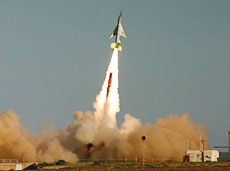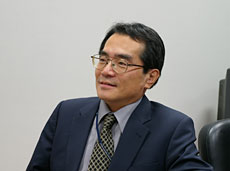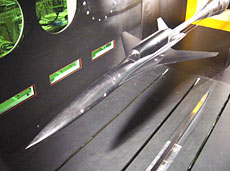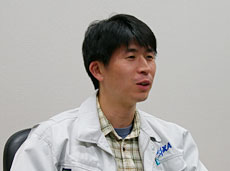

Flight experiment with the National Experimental Supersonic Transport (NEXST-1) in 2005

Q. How far has the technological development of supersonic aircraft advanced?
Ohnuki: Large-scale research program for supersonic transport technology is launched at JAXA in 1997, and technological development has since progressed in collaboration with Japanese aircraft industries. We are currently in the second phase of the program. In the first phase, our goal was to acquire design technology to minimize aircraft aerodynamic drag at cruise, and in 2005 in Australia, we successfully executed a flight demonstration experiment of the National Experimental Supersonic Transport (NEXST-1) in Australia. The scaled experimental airplane was designed using the inverse design methodology, which we explained earlier, to minimize aerodynamic friction drag on the main wing surface. Because it didn't have an engine, NEXST-1 airplane was launched by a solid rocket booster. The airplane was accelerated to Mach 2.0 and separated from the booster at an altitude of around 19 km, and took off at Mach 2. The data acquired in the flight experiment matched our previous analysis, confirming that the aircraft configuration, which was designed using the computer program, would in fact reduce aerodynamic drag. During the flight test, we also measured the sonic boom on the ground, in preparation for the next step.
Currently, in the second phase, we are working on noise reduction while maintaining aerodynamic performance. In particular, we are keen to become the first in the world to demonstrate technology that reduces sonic booms by optimizing whole aircraft configuration. The United States and Europe are also studying sonic booms, and they have already proven that a part of sonic boom sound can be reduced by the shaping of an aircraft nose is key to some sonic boom reduction. But at JAXA, we are trying to minimize sonic booms overall by optimizing the design of the entire airframe, so that it will be a much quieter aircraft. Application of the numerical simulations and wind tunnel validations, we are getting better ideas about the relationship between aircraft configuration and sonic boom reduction. In reality, though, sonic booms are also affected by atmospheric properties such as temperature and atmospheric density, humidity, and disturbances caused by wind. Such natural phenomena are so difficult to simulate on the ground that flight tests are imperative for the final technology demonstration. We are planning to conduct a flight test with a silent supersonic technology demonstrator by the mid-2010s.
Q. What is the agenda for the technological development of supersonic aircraft?
Ohnuki: First of all, the development of supersonic transport is such a large project that it is too difficult for a single nation to complete it alone. Europe and the United States share this view with us. In fact, the Concorde was a joint project between France and the United Kingdom. But at this point, international collaboration on developing a supersonic passenger aircraft is not happening yet - each nation is engaged in technical research individually. In my opinion, foremost on the agenda is setting up an atmosphere for international collaboration.

Design verification by wind tunnel test
Makino: Although computer analysis has been applied to the optimization design system, we need to continue improving the analysis technology. Finally, supersonic aircraft technology ought to be demonstrated in a flight test, but because producing a demonstrator is so expensive, we have to verify our design technology as much as we can on the ground research, through numerical analysis and wind tunnel tests, before we build a flight demonstrator. In order to confirm the model design, we have to improve the computer's prediction accuracy - and that means we need a lot of data to validate the analysis. The problem is, though, that we don't have enough flight date for comparison data, since we don't have much experience to develop a supersonic airplane in Japan.
Of course it's possible to acquire validation data of airflow and pressure distributions with wind tunnel tests to a certain extent. The principle of a wind tunnel test is that, to simulate an aircraft flying at Mach 1.6 in the atmosphere, for example, we place a scale model in the wind tunnel and generate a Mach 1.6 wind. But in reality, there are inevitable differences between an aircraft moving through the air and an aircraft in a stationary position with wind moving around it. In a wind tunnel, you need to use some kinds of supporting systems such as stings or struts to hold the model and take their influence into account, so we are now testing different types of supporting systems in order to conduct wind tunnel tests without their influence on the measured data.
Q. Could you tell us about your next goal or dream?
Ohnuki: I'd like to complete R&D for silent supersonic technology. I cannot wait to verify the technology with a demonstrator aircraft. I'm also looking forward to the rollout of the silent supersonic technology demonstrator. The demonstrator will be larger than the previous experimental airplane we built for the flight experiment in Australia in 2005 - closer to an actual aircraft configuration with an engine and landing gears. I think it will be quite a moving sight. Also, I'd love to fulfill a large-scale supersonic passenger aircraft in the future. And on a personal note, I'd like to experience a supersonic flight someday myself. It is a pity that I never had an opportunity to fly on the Concorde, but it'll surely be more exciting to fly beyond the speed of sound on a supersonic aircraft we developed ourselves.

When I attend international workshops or academic conferences on supersonic transport, I feel that our 2005 flight test in Australia was positively assessed overseas. This is partly because the number of flight experiments is decreasing worldwide. There is an atmosphere where basic research is encouraged more than expensive flight experiments, and as a result, each year there are fewer opportunities of building demonstrators and flight demonstrations. All the more, many people overseas want Japan to continue this project. I am looking forward to achieving results and living up to their expectations.
Dr. Takeshi Ohnuki
Leader, Supersonic Transport Team, Aviation Program Group, JAXA
Dr. Ohnuki graduated in 1980 and completed his doctorates in 1985 from the Department of Aeronautics and Astronautics at the University of Tokyo, In 1980, he joined the National Aerospace Laboratory of Japan (now part of JAXA), and was engaged in research in high efficiency aircraft. From 1989 to 1990, Dr. Ohnuki was a visiting fellow at Bristol University in the United Kingdom. From 1992 to 1997, he was on loan to the Japan Science and Technology Agency. Dr. Ohnuki has been involved in R&D of supersonic transport since 1997, and has been in his current position since 2005.
Dr. Yoshikazu Makino
Senior Researcher, Aerodynamic Design Technology Section, Supersonic Transport Team, Aviation Program Group, JAXA
Dr. Makino graduated in 1993 and completed his doctorates in 1998 from the Department of Aeronautics and Astronautics at the University of Tokyo, In 1998, he joined the National Aerospace Laboratory of Japan (now part of JAXA), and was engaged in research on CFD aerodynamic design optimization technology for the supersonic technology R&D project. From 2003 to 2004, he was a visiting fellow at Stanford University in the United States. He is currently in charge of aerodynamic design for the Silent Supersonic Technology Demonstrator.
Leader, Supersonic Transport Team, Aviation Program Group, JAXA
Dr. Ohnuki graduated in 1980 and completed his doctorates in 1985 from the Department of Aeronautics and Astronautics at the University of Tokyo, In 1980, he joined the National Aerospace Laboratory of Japan (now part of JAXA), and was engaged in research in high efficiency aircraft. From 1989 to 1990, Dr. Ohnuki was a visiting fellow at Bristol University in the United Kingdom. From 1992 to 1997, he was on loan to the Japan Science and Technology Agency. Dr. Ohnuki has been involved in R&D of supersonic transport since 1997, and has been in his current position since 2005.
Dr. Yoshikazu Makino
Senior Researcher, Aerodynamic Design Technology Section, Supersonic Transport Team, Aviation Program Group, JAXA
Dr. Makino graduated in 1993 and completed his doctorates in 1998 from the Department of Aeronautics and Astronautics at the University of Tokyo, In 1998, he joined the National Aerospace Laboratory of Japan (now part of JAXA), and was engaged in research on CFD aerodynamic design optimization technology for the supersonic technology R&D project. From 2003 to 2004, he was a visiting fellow at Stanford University in the United States. He is currently in charge of aerodynamic design for the Silent Supersonic Technology Demonstrator.
Leading Japan's Aviation Industry
JAXA's Initiative for the Development of Clean Engine Technologies in Japan
For Fulfillment of Quiet Supersonic Passenger Aircraft
JAXA's Initiative for the Development of Clean Engine Technologies in Japan
For Fulfillment of Quiet Supersonic Passenger Aircraft